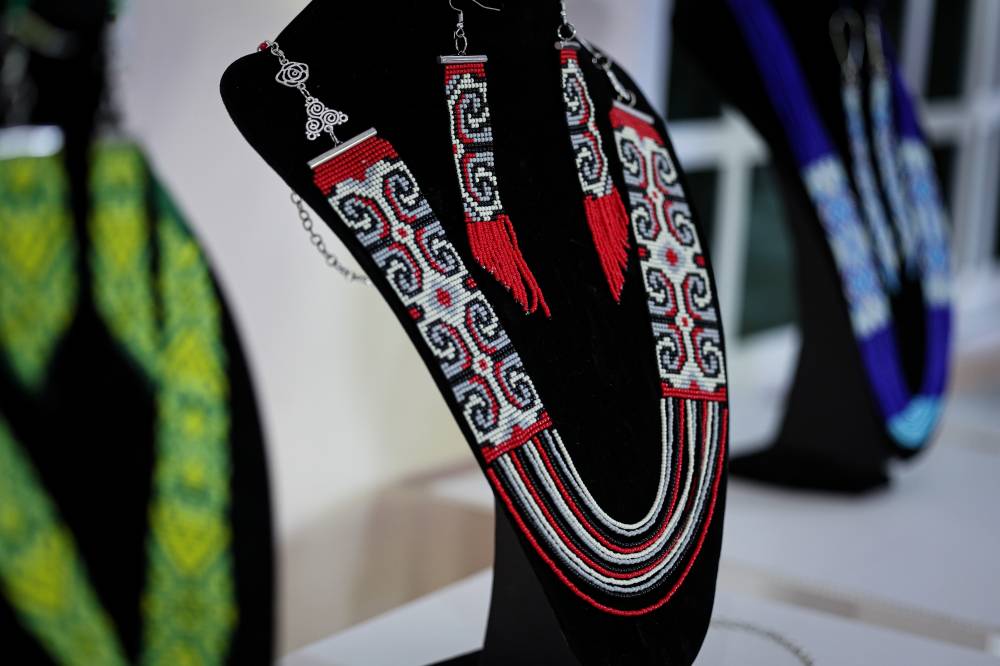Kraftangan Malaysia empowers Bintulu craft community
The craftwork requires a great deal of meticulousness.

BINTULU - In the spacious verandah of a modern longhouse in Bukit Bethany here, a group of women could be seen focusing intently on their beaded embroidery works, one of the traditional crafts of the Iban community residing in the Bintulu area. The smaller the beads, the more intricate the process of creating the exquisite beadworks for which Sarawak is famous.
They were among 15 women who participated in the Bead Craft Product Development and Production Lab programme from June 24-27, organised under the Community Skills Development Project (PPKK) which is an initiative of the Malaysian Handicraft Development Corporation (Kraftangan Malaysia) to empower local communities by enhancing their craft-making skills and enabling them to set up enterprises from which they can generate an income.
Bernama’s visit to Bintulu as well as Lusong Laku, Belaga, was part of a four-day media tour organised by Kraftangan Malaysia from June 27 to 30.
Kraftangan Malaysia director-general Datuk 'Ainu Sham Ramli, who also participated in the media tour, handed out certificates to all those who took part in the Bead Craft Product Development and Production Lab programme.
COMPLICATED
As attested by craft entrepreneur Johiam Jitui and two other designers from Kraftangan Malaysia - who showed the lab participants the finer details of the art of making beaded embroidery - the craftwork requires a great deal of meticulousness.
Johiam, 49, has been involved in creating beaded embroidery crafts for 12 years and owns a boutique in Kuching.
"It's not easy to make them because the smaller the bead, the more complicated it is (to do the beaded embroidery) due to its tiny hole and the delicate floral patterns.
Among the things Johiam highlighted to the lab participants were the skills they would need to learn to master the fringe embroidery bead weaving technique.
On the creation of beaded products such as earrings and necklace sets, Johiam said colour coordination plays a crucial role so as to make the accessories appear more exclusive and elegant.
She said it takes about three days to complete a necklace which sells for around RM150, while a pair of earrings, priced at around RM80, takes two days to finish.
Regarding the marketing of the beaded crafts produced by the women of Bintulu, Johiam said most of them sell their handicrafts in the surrounding areas and at exhibitions and during festivals like Gawai. Johiam herself helps market their products in Kuching and at her boutique.
TANGO
Cyinthia Amoi, 43, who was among the lab participants, said she began dabbling in beaded crafts at the age of 12, inspired by her sister’s craftsmanship.
As a child, she said, she would make the tango with beads and use them as decorative wall hangings. The tango is an ornament, decorated with coins or cotton balls, traditionally worn by Iban women to cover their chests.
Cyinthia, who is a supervisor at Samalaju Port, gradually fell in love with beaded embroidery and always made it a point to attend workshops organised by Kraftangan Malaysia to improve her knowledge and skills.
She also said several types of beads can be used for making crafts, including Naga beads and Indonesian and Japanese beads.
"I prefer using fine beads and Naga beads because they produce beautiful works. To make beaded earrings, one must be creative and come up with unique designs.
"It all depends on the individual. Sometimes their designs may look ordinary but if skillfully combined with the right colours, the end-products will certainly look captivating,” said Cyinthia, who favours a combination of three colours: blue, dark red and turmeric yellow.
She also said the demand for beaded crafts has been very encouraging and hopes more young people will take advantage of the craft development programmes provided by Kraftangan Malaysia.
The youngest participant Alexandra Adowen, 18, described learning the beaded embroidery technique as a new experience.
Alexandra, who is awaiting admission into the government’s Matriculation programme, said she learned to make lanyards and keychains from beads at an earlier workshop last December. At the recent lab session, she gained skills in making earrings.
"At first, it was difficult to master this technique as the different designs confused me. But eventually, I got the hang of it and started to enjoy it,” she said, hoping to monetise her newly acquired skills someday.
COMMUNITY EMPOWERMENT
Meanwhile, Kraftangan Malaysia’s 'Ainu Sham said the Bead Craft Product Development and Production Lab programme in Bintulu was conducted in two phases. The second phase, held from June 24 to 27, focused on the fringe embroidery bead weaving technique while the first phase, from Dec 7-10, 2023, saw participants being introduced to basic bead embroidery techniques using loom equipment.
She also said PPKK is an initiative by Kraftangan Malaysia to improve the socioeconomic status of local communities by providing them with the technical and entrepreneurial skills relevant to the crafts they produce in their localities.
Up to 2024, Kraftangan Malaysia has successfully implemented 14 PPKK activities in Sarawak, involving 247 participants, covering textile crafts, forest products, metal products and various other crafts.
'Ainu Sham added Kraftangan Malaysia’s efforts and initiatives have indirectly empowered craft entrepreneurs in Sarawak.
"Currently, there are 1,237 craft entrepreneurs in Sarawak, with 49 of them based in Bintulu,” she said, adding she hoped Bintulu will one day become a hub for the production of beaded crafts that can be commercialised, not only in the local market but also internationally.
'Ainu Sham also encouraged the local women to create beaded crafts with a distinctive Bintulu identity, setting them apart from beaded crafts found elsewhere.
"We know beaded crafts are also found in other places like Sabah, so we want the community here to find something unique that would highlight the identity of Bintulu so that when people see their beaded products, they will know and recognise them as Bintulu crafts,” she said. - BERNAMA










